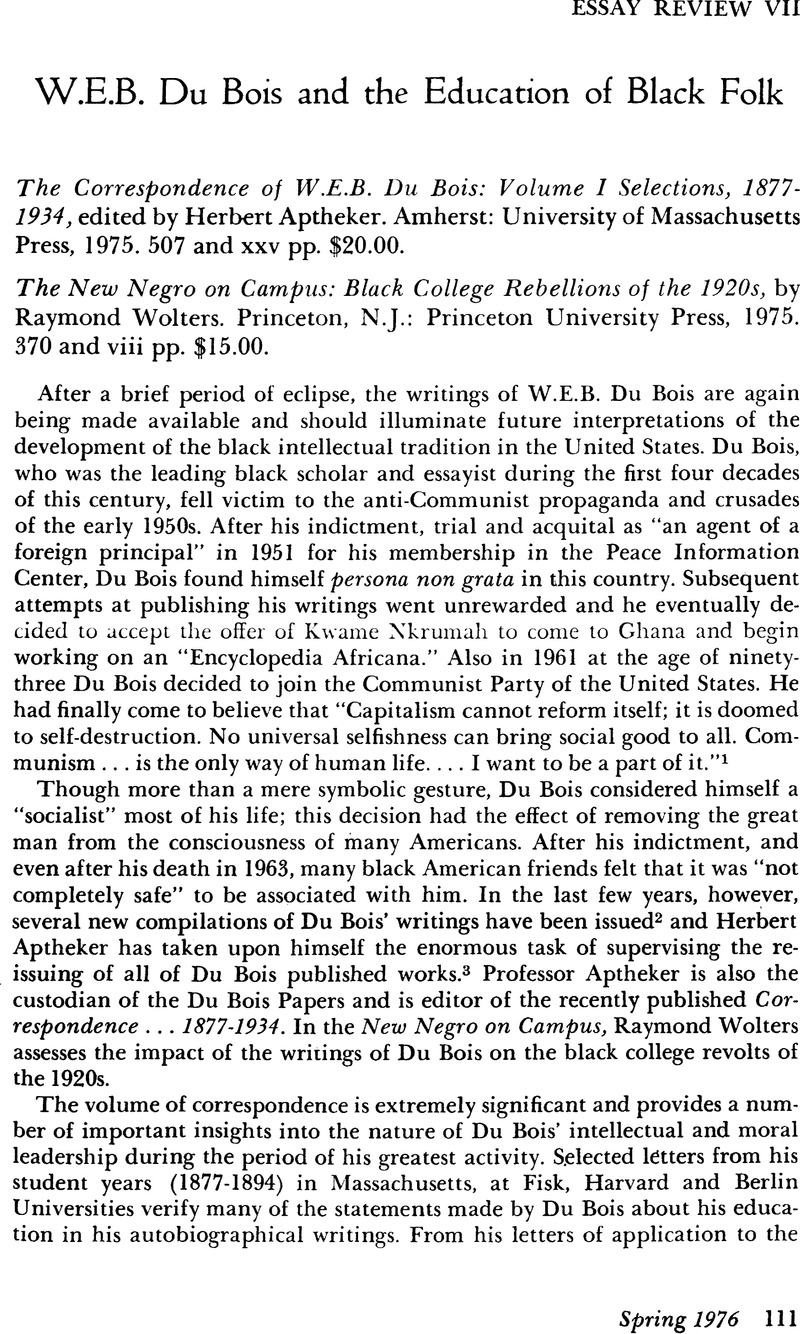Article contents
W.E.B. Du Bois and the Education of Black Folk
Published online by Cambridge University Press: 24 February 2017
Abstract

- Type
- Essay Review VII
- Information
- Copyright
- Copyright © 1976 by New York University
References
Notes
1. Quoted in “Introduction,” to The Seventh Son: The Thought and Writings of W.E.B. Du Bois, Volume I, edited by Lester, Julius (New York, 1971), p. 144.Google Scholar
2. Ibid., Volumes I & II; Walden, Daniel, ed., W.E.B. Du Bois: The Crisis Writings (New York, 1972); Tuttle, William M. Jr., ed., W.E.B. Du Bois (Englewood Cliffs, N.J., 1973).Google Scholar
3. Du Bois, W.E.B., The Collected Works of W.E.B. Du Bois, Edited and with Introductions by Herbert Aptheker (New York, 1974-). The first ten of forty proposed volumes have been issued.Google Scholar
4. Idem, Dusk of Dawn: An Essay Toward An Autobiography of a Race Concept (New York, 1940), pp. 289–323. For a recent study of these controversies, see Ross, B. Joyce, J. E. Spingarn and the Rise of the NAACP, 1911–1939 (New York, 1973).Google Scholar
5. See, for example, Huggins, Nathan, Harlem Renaissance (New York, 1971), passim; Rudwick, Elliot, “The New Negro and the Old Du Bois,” in W.E.B. Du Bois: Propagandist of the Negro Protest (Philadelphia, 1960), pp. 236–271.Google Scholar
6. Cf. Davis, Arthur P. and Peplow, Michael W., eds., The New Negro Renaissance: An Anthology (New York, 1975); Levy, Eugene, “The Harlem Renaissance” in James Weldon Johnson: Black Leader, Black Voice (Chicago, 1973), pp. 297–321. See also, Locke, Alain, ed., The New Negro: An Interpretation (New York, 1925).Google Scholar
7. Du Bois, W.E.B., The Education of Black People: Ten Critiques 1906–1960, edited by Aptheker, Herbert (New York, 1973).Google Scholar
8. Du Bois, W.E.B. to Frantz, F. E., June 16, 1921, in The Correspondence of W.E.B. Du Bois, pp. 249–250.Google Scholar
9. Du Bois, W.E.B. to Rev. Waldron, J. A., July 25, 1923, in ibid., p. 273.CrossRefGoogle Scholar
10. Du Bois, , “Does the Negro Need Separate Schools?” The Journal of Negro Education, 4 (July, 1935): 335.Google Scholar
11. Idem, “Negroes in College,” Nation, 122 (March 3, 1926): 228–230.Google Scholar
12. Logan, Rayford, Howard University: The First Hundred Years (New York, 1969).Google Scholar
13. Neyland, Leedel W. and Riley, John W., The Florida, Agricultural and Mechanical University (Gainesville, Florida, 1963).Google Scholar
14. Graham, Edward K., A Tender Violence: The Biography of a College (forthcoming).Google Scholar
15. Daniel, Pete, “Black Power in the 1920s: The Case of the Tuskegee Veterans Hospital,” Journal of Southern History, 36 (August, 1970): 368–388.Google Scholar
16. Du Bois, , “Fisk” in W.E.B. Du Bois: The Crisis Writings, p. 167.Google Scholar
17. Idem, “Education and Work,” in The Education of Black People, pp. 61–82.Google Scholar
18. Idem, “The Field and Function of the Negro College,” in ibid., pp. 91–92, 100.Google Scholar
- 1
- Cited by




